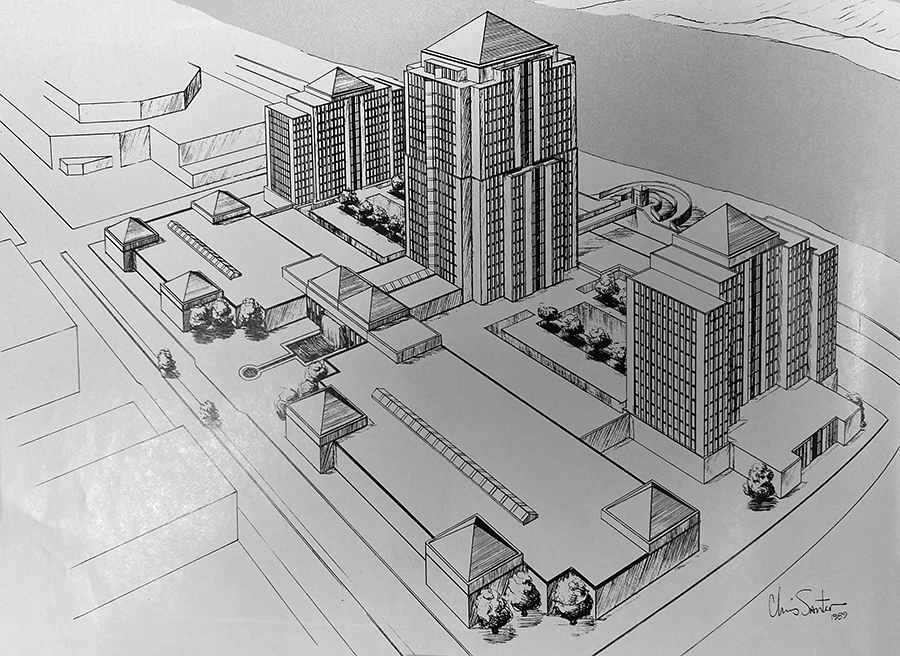A city built on the banks of the Ohio River embarks upon a new decade of opportunity.
By Abbey L. Zink
HQ 2 | WINTER 1990
AFTER A HARD DAYS WORK, 30-year-old Jonathan Riske, an independent investment adviser, locks up his prestigious 20th floor Huntington Tower office and heads toward the elevators. Emerging from a crowded elevator at the second floor, Jonathan walks swiftly toward the medway entrance where his wife, Lisa, awaits. He clasps her hand as they leisurely stroll across the Veteran’s Memorial Boulevard medway and take the glass elevator down to the Harris Riverfront Park walkway. They laugh as they walk along the river, making their way toward the Eighth Street entrance. Passing the get ski rentals and the West Virginia Belle’s permanent dock, Lisa reminds Jonathan that they have a full weekend ahead. Faint calliope music beckons as they near the colorful Collis P., an Ohio River stern-wheeler turned floating restaurant. A maitre d’. Dressed as a riverboat gambler, greets them at the entrance. Later, seated at a table overlooking the majestic Ohio, the Riskes smiles. Their hometown has come into its own.
Much maligned for nearly 20 years, Huntington is a diamond in the rough, a jewel on the Ohio waiting to be discovered, polished and transformed. Natural resources abound as does an ample and skilled labor force. The city has what it takes to be a major player. And, the word is spreading.
“The resources and the dynamics that are needed to have the kind of economic growth that we’re seeing in other communities all are here,” says Mayor Robert R. Nelson.
The greater Huntington area is located within 500 miles of roughly more than half of the population of the United States. Four distinct seasons, cheap energy sources produced within the state and excellent transportation systems, including rail, river and interstate, make the area very attractive.
In addition, the quality of life is unparalleled. West Virginia boasts one of the lowest crimes rates in the United States. Boating, skiing, whitewater rafting, hiking, camping, hunting and virtually any other outdoor activity that comes to mind is close by. Excellent schools, a major university, a large capacity civic center, minor league baseball, a highly-regarded park system, a paddle-wheel floating restaurant and a nationally recognized Museum of Art all work to make the area attractive to outsiders.
“Quality of life, rather than tax rates, is what business executives look for when they are looking to relocate,” Nelson says. “Tax rates tend to even out throughout the nation and rank anywhere from fourth to tenth in order of importance.
“It comes down to that general term ‘quality of life.’ We can compete very well there. What we don’t have is some of the facilities to put these people in when they come.” He said.
Particularly, Huntington is in desperate need of top quality, Class A office space. This need seems to increase each day as more and more companies contact the city about possibly relocating here.

For example, last month Nelson met with a gentleman from North Carolina who owns a finishing plant for garments and is interested in relocating. “He’s heard about this place. He came up on his own. He likes it and he’s interested in coming here,” Nelson said.
This business owner is just one of many who have either considered relocating or have relocated in the greater Huntington area since 1985. Huntington now has one of the lowest unemployment rates in the state and has added more than 3,300 new jobs in the last year, alone.
The city also has been filling buildings that were vacant for years. For example, the former sites of Kerr Glass, Corbin and Houdaille Industries all are homes to new businesses. In addition, the city’s traditional heavy manufacturing base is pulsating with life. Inco Alloys International, BASF Wyandotte Corporation, Owens-Illinois and ACF Industries all are thriving.
Moreover, the retail end is bursting with new energy as well. The downtown Stone and Thomas store is the second best in the chain in terms of sales. Since opening, Red Lobster has remained among the top five stores in gross sales in the Northeast region. Jim’s Steak and Spaghetti House, Ming’s, Chili Willi’s and Steak and Ale are among area establishments that have lines on the weekends. And, bus tours are triple what they were a year ago. “If you have a good product, people find it,” Nelson said.
And, the future looks even brighter as the city continues to gain momentum.
Says Edward H. Diehl, director of the Huntington Urban Renewal Authority, “You have our agency and all of the others – the mayor, the city council, the chamber of commerce and the visitor’s bureau – and it seemed like a number of years ago, before Mayor Nelson’s reign, that all of these little so-called power structures tried to do their own thing. Now this isn’t happening anymore. That’s a big asset in itself.”
With Huntington on the verge of outgrowing the economic malaise of the last two decades, this dynamic coalition must now decide how best to prepare the city for an even brighter future … a future tied inextricably to the Ohio River.
RiverCenter
For nearly 15 years, the city, in conjunction with the Huntington Urban Renewal Authority, has been working to develop the 9.16 acres of downtown known as Superblock. “That’s been the cross wear bear here in Huntington,” Nelson said. “It kind of symbolizes the continuation of some of our economic stagnation or the jumping off point of a new, revitalized downtown that will lead the way into the 21st Century.”
The latest of a handful of attempts to develop the area was initiated about four years ago by the Webb Companies of Lexington, Ky. Webb spent about $125,000 on a development study for a project called RiverCenter.
Webb Companies is a large development firm that has developed projects in more than 40 states. Charleston’s Laidley Tower and Lexington’s Festival Market are both Webb projects.
RiverCenter would have solved Huntington’s need for Class A office space. The $125 million project called for three office buildings, 60,000 square feet of upscale retail space for stores of the same caliber as a Saks Fifth Avenue department store or a Liz Claiborne boutique, a pedestrian mall and food court built around a large fountain, a 2,000-car parking garage, a suite hotel, and a medway across Veteran’s Memorial Boulevard to further tie the project to the Ohio River. A 20-story office tower would have dominated the site with seven-to-10-story towers on either side for balance. Also, by moving existing retailers such as Amsbary’s and Stone and Thomas to RiverCenter, the area across Third Avenue would have been gutted and transformed into an outlet mall.
Rather than try to lure traditional stores such as Sears, J.C. Penny or Kmart to RiverCenter, Webb sought to complement the existing retail market with stores that would give the region another dimension. “ If you look around, there isn’t an upscale market here,” Nelson said. “You’ve got to go to Lexington or Columbus if you’re looking at some of the really nice shops. So the thing was to have own own little Beverly Hills or whatever you call it.”
RiverCenter was to have been a magnet to draw people to the area. It would have provided the office space needed to attract regional corporate offices for $15-16 a square foot, an excellent rate for Class A office space. “We would have the tallest building in West Virginia in the largest city in West Virginia in the most prestigious location,” Nelson said. “And, that’s where a great business wants to be. That’s where they want to hang out their address.”
Although the city virtually had all 20 floors of the main tower leased before construction was scheduled to begin, the project fell through because two major businesses in the city had targeted to anchor the tower wouldn’t commit at that time. “The Webb people took it as far as they could because they put together the project, they had the financing, they were ready to go. But, it was up to the private sector to pull it all off,” Nelson said. “It was a bitter disappointment for me because it would have really been the redevelopment of downtown, particularly the Superblock area, that we’ve been looking for.”
If given their choice, officials said they would like to see the RiverCenter idea resurrected and developed.
Outlet Mall
Over the years, the city has been approached by various individuals interested in placing car dealerships, supermarkets and other types of piecemeal development on the SuperBlock site. Until recently, officials have fought against such attempts, but now realize that such development can work if the mix of businesses involved enhance the downtown area.
Diehl said the Huntington Urban Renewal Authority gave its approval for piecemeal development because the agency feels that may be the best way to get the project moving. “I feel like it might have to be done. We’ve tried to look at it as a total development from on developer, but we’ve been trying for so many years with four or five different developers and it hasn’t come to pass,” Diehl said. “So, our board of commissioners and this agency has given their blessing to piecemeal development if it’s approved by the city.”
Strong interest has been expressed to develop a major outlet mall in conjunction with the RiverCenter project. Something may well come from that proposal, Nelson said.
Development of a major outlet mall on the site would be the catalyst needed to draw customers back to downtown in big numbers. An outlet mall also would complement the existing retail market, giving the area another dimension of shopping that possibly would attract toasts as well. In addition, theme restaurants would work well with the development. In fact, Chi-Chi’s, a national chain of restaurants, and a Bennigan’s-type establishment have approached Huntington about locating in the area.
If an outlet mall is built on the site, Nelson said the city hopes to attract local developers and investors. “If we can use our local entrepreneurs, investors and contractors that could save us considerable money and also allow the possibility of local ownership, that would give a little more pride and commitment to the development.”

Huntington City Council President Bill Evans is exploring the possibilities of bringing quality, direct factory outlet stores to the city. Thus far, response within the city has been positive. “It’s like mom and apple pie. Everyone I’ve talked to likes the idea.”
If outlet stores do come to Huntington, Evans said he isn’t sure they will be built in conjunction with RiverCenter. He said he prefers the idea of creating a factory outlet district within the city, perhaps in existing buildings.
Evans said he believes bringing outlet stores to Huntington is a worthwhile endeavor. Huntington needs something to create activity for the increased number of tour buses coming to the city and for the crowds at Marshall football games when the new stadium is completed.
Diehl said he believes the city is close to developing the RiverCenter. “I hope within the next year that we start building. That’s our ambition and goal. We’ve come very close many times. Now that we’re accepting piecemeal development offers I feel that we’re that much closer.”
Nevertheless, whether it be a RiverCenter-type development or a major outlet mall, officials are determined to integrate the project with the city’s greatest asset – the Ohio River.
Ohio River
Nelson likens the Ohio River to a ribbon and views its prudent use as the key to the city’s continued economic growth. The river cities – Huntington, Ashland and Ironton – all share a common thread and development in one city can only help the others. He points to the proposed new Sixth Street bridge as an improvement that will benefit the entire region. The proposed four-lane bridge will provide a modern link to specialty and mall shopping throughout the river cities.
“We’re all along the river here and the river no longer can be looked upon by us as a barrier or a wall,” Nelson said. “It’s now a ribbon that we can throw out in bright colors and this ribbon can take you to what all’s going on in the Tri-State region. That’s why we’re looking now not just at our own city, but the region and the Tri-State.”
But, the mighty Ohio River need not only be looked upon as a means of transportation. As evidenced by Harris Riverfront Park, the West Virginia Belle and the new marina, the river can also be used for recreation and economic development.
Harris Riverfront Park
Shunned by city residents for more than 50 years following the 1937 flood, the Ohio River has only recently been rediscovered. Harris Riverfront Park, built in the 1970s, quickly has become one of the city’s most popular recreation spots. So popular, in fact, that is has nearly reached its saturation point.
An effort now is under way to enlarge the park by 75 percent. The city and the Corps of Engineers has developed a proposal that will extend the park nearly to where the Sixth Street bridge is now. The proposal calls for cutting an additional opening in the flood wall at Eighth Street, where more parking will be made available. In addition, the West Virginia Belle will be relocated to a permanent dock at the end of the park and a driveway for tour buses to enter will be constructed. The overall design, however, will remain the same.
Nelson said the city has already contacted 4th District Congressman Nick Joe Rahall and U.S. Senator Robert Byrd about getting money in the next federal budget for the expansion of the park. About 25 to 30 percent of the expansion possibly qualifies for federal assistance. Nelson hopes the federal government will pick up the tab for more than $300,000 of the proposed $1.3 million project. The rest will be raised by the city in conjunction with the Huntington Urban Renewal Authority.
Commercial development along the Ohio is possible, but not desirable. “People are attracted to water and trees and greenery and if you have that, it’s another plus we have in this community,” Nelson said. “We have it and it hasn’t been overly developed or commercialized so we can have some balanced and orderly development so that we don’t throw the baby out with the bathwater, that we don’t sacrifice one for the other.”
Rather, development on the river is encouraged. A first-class floating restaurant would greatly enhance the river front. The city also has considered offering jet ski rentals, building a beach or even a swimming pool in the Ohio. Pontoon boat rentals also would help draw more families to the river. All are feasible, according to Ben Borda, a landscape architect in the U.S. Army Corps of Engineers’ planning division. The difficult part, Borda said, is finding a stumble location.
Marina
Huntington’s marina has the potential for being on the city’s top attractions. But, development has been slow because the owner has had difficulty raising sufficient capital to construct the marina the way the city originally envisioned it. The goal was to build a first-class facility that would complement Harris Riverfront Park, Nelson said.
Over the past few months, a lot of internal work has been done at the marina. The huge barge that houses the structure is being completely outfitted below deck for marina stores and offices. But, a lot of work remains to be done. For example, the number of slips still is half of what the city originally envisioned.

Having a first-class marina could mean more than increased recreational activity on the river. In fact, such a marina could have a profound economic impact on downtown. Boaters could dock their boats and be within walking distance of several restaurants, the Radisson, the Civic Center and, perhaps, even an outlet mall or large development.
“The river is a very important part of our city, and it’s never really been part of the city’s economic future before,” Nelson said. “But, as we have seen from just Harris Riverfront Par, the floating stage and the West Virginia Belle, there’s a lot of potential there.”
Investment
What Huntington needs more than anything else is a generation of investors with the vision and faith of city founder Collis P. Huntington. Increased support from the private and financial sectors easily could put the city back on the road to realizing its blinding potential.
“That’s what Webb saw,” Nelson said. “They really believed that we have a better potential for the kind of development that RiverCenter represented than Charleston or Lexington.”
RiverCenter, the marina and countless other projects have fallen victim to the private and financial sector’s apparent lack of vision. But, all is not lost. With support from local investors and financial institutions, RiverCenter or a major outlet mall could be built, the marina could be brought up to first-class status and the city could begin to reap the harvest of substantial tourist dollars.
FOLLOWING BREAKFAST AND Saturday morning cartoons, the Riske daily leaves for the riverfront. Lisa and 4-year-old Amy have made plans to spend the day shopping at the newly constructed RiverCenter Mall. Jonathan has promised 6-year-old Justin they will rent a boat at the marina and go fishing for a couple of hours. At 2 p.m., they all meet for lunch at Chi-Chi’s and decide to visit the cultural museum, where the Ohio River Odyssey is permanently housed. Two or three hours later, they call it a day. During the drive home, the Riske family admires the Huntington skyline as the horizon turns to black.
Their hometown has arrived.





